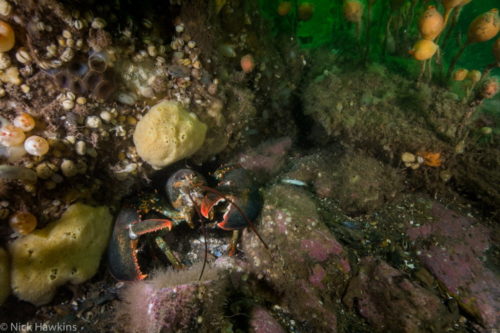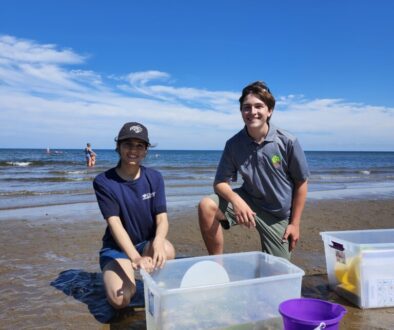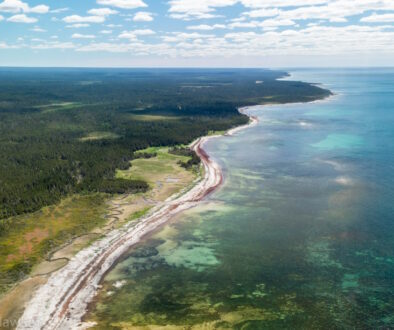10 More Underrated Species of the Bay of Fundy
Happy Oceans Week! As we take time this week to celebrate the oceans, the species they contain, and all of the incredible things they do for our world and way of life, we look to the winding coasts and vast blue Bays of New Brunswick. With 5,500 km of shoreline in salt marshes, sand dunes, and steep, rocky cliffs, our province is home to diverse plants and animals that endure the salty ocean environment.
To the north in the Baie des Chaleurs, you’ll find the very rare maritime ringlet butterfly fluttering along the coast or groundfish, like the threatened American Plaice, living on the ocean floor. To the east in the Northumberland Strait, you’ll find your seafood favourites: scallops, lobster, and oysters. And to the south, the rich and vibrant Bay of Fundy is home to more species than we can count, some more endearing than others. These weird and wonderful wildlife (and one plant) are our picks for 10 More Underrated Species of the Bay of Fundy.

1. Atlantic wolffish – Certainly a weird and wonderful species, Atlantic wolffish have many teeth in their big mouths, including along the roof of their mouths! This helps them to easily eat tricky prey, like sea urchins and crabs, who have few other predators. By eating up these hardy species, wolffish help to keep their populations in check. Atlantic wolffish help to keep food webs and ecosystems healthy, which makes protecting them and their habitat so important.
2. Copepods – Copepods are a tiny crustacean, a relative of crabs and lobsters, about the size of a grain of rice. They, along with other tiny ocean animals and plants, form the bottom of the ocean food web and keep ocean ecosystems going– one of the reasons why the Bay of Fundy is home to so many species. Copepods are especially important because they are the preferred food of the critically endangered North Atlantic right whale!
3. Rockweed – Rockweed is the general name for a few types of seaweeds found sprawling along the shorelines of New Brunswick. With tiny pockets of air, called “air bladders”, rockweeds are able to float. At high tide, clumps of floating rockweed create a forest-like habitat that many birds and fish use. At low tide, these seaweeds provide protection from predators and the elements for animals like crabs, periwinkle snails, and barnacles.

4. Northern Gannet – Northern gannets have amazing eyesight, both in air and water! This large seabird can spy its prey- schooling fish, while soaring high above the ocean. They then dive bomb the water from the sky, causing a splash that can be seen at a distance. The neck and shoulders of the gannet are protected by air cells that inflate prior to their dive- their own built in airbags!
5. Northern barnacle – Another unique crustacean, the Northern barnacle is a small animal that permanently attaches itself to any hard structures found in the ocean: rocks, wharves, and even other animals, like lobsters and whales! This species begins its life as a free-floating larva and later settles onto a surface, solidifying its existence using a cement-like substance that scientists have explored as an alternative to dental adhesive!
6. Moon jelly – A very common jelly that is certainly underrated! You can see moon jellies nearshore from harbours, wharfs, and beaches because this species, like many other jellies, thrive in places highly impacted by people. As our activities increase, competition between moon jellies and other species for food decreases, allowing these populations to boom! As climate change impacts unfold and human activities continue, the moon jelly may just become a most populous species in the Bay of Fundy.

7. Northern red anemone – Most of us conjure up bright images of coral reefs when we think of anemones (thanks, Finding Nemo), but we too have anemones right here at home! Northern red anemones can grow up to 15cm in diameter and use their tiny tentacles to catch, sting, and then eat prey like crabs and small fish. These beautiful creatures are animals, not plants, but they’re unique in their ability to reproduce by simply diving their body in half!
8. American eel – Technically a fish, American eel are the only “catadromous” fish in North America. This means that American eels spawn and are born in the ocean, but mature in freshwater lakes and rivers. Because they can live in so many places, some say that American eels have the widest diversity of habitats of any fish species in the world!
9. Porbeagle shark – Porbeagle sharks are just one of many types of sharks that make their way to the Bay of Fundy each year. Porbeagle sharks are close relative to the great white shark, so close that they are often confused when seen in the wild.This shark grows to be up to 2 metres and 300 pounds! Porbeagles are considered as Endangered by the Committee on the Status of Endangered Wildlife in Canada (COSEWIC), but are not yet legally protected by Canada’s Species at Risk Act.

10. Black-legged kittiwake – So much more than “just a gull”, the black-legged kittiwake nests in tiny crevices in the cliff face, usually far offshore. This small gull, about the size of a crow, with it’s signature black legs dips and plunges into the sea surface to catch small fish. It’s easy to confuse a juvenile black-legged kittiwake with an adult Bonaparte’s gull because of their black bills– it isn’t until adulthood that this bird’s bill turns yellow.
Home to more than 2,000 species of plants and animals, the Bay of Fundy is one of New Brunswick’s most diverse and most exciting ecosystems. Today, our Bay goes without protection and is threatened by human activities and impacts from climate change, including the dangers of warming oceans and shifting food webs. CPAWS-NB is working hard to change this!
With your help, we have been advocating for a network of Marine Protected Areas (MPAs) for the Bay of Fundy. A network of MPAs would protect the most important habitats and species in this ecosystem and, with other and larger MPAs in the Scotian Shelf and Northwest Atlantic, could help to ensure that oceans remain healthy and productive long into the future.
Add your voice to our campaign to protect the Bay of Fundy today!
Header photo by Nick Hawkins

Courtney Piercy holds a Bachelor of Science in Marine Biology and a Bachelor of Education, and is currently the Marine Education Coordinator at CPAWS NB. Growing up, Courtney had many opportunities to experience our province’s nature- inspiring her to work in the environmental field. She has ample experience in environmental education on the Bay of Fundy, having worked in the whale watching industry since 2012. From this experience, she has seen first-hand how important it is to expand ocean conservation in New Brunswick!

Julie Reimer is a PhD student at the Memorial University of Newfoundland and a Board Member of CPAWS-NB. Having worked in the whale watching industry in New Brunswick and conducted her Master’s research on conservation planning for the North Atlantic right whale, Julie is an advocate for MPAs in New Brunswick. Julie’s current research attempts to see the “bigger picture” of conservation, reaching beyond protected areas to understand the synergies between conservation actions and ocean industries. To connect with Julie, visit http://juliereimer.wixsite.com/hello.



